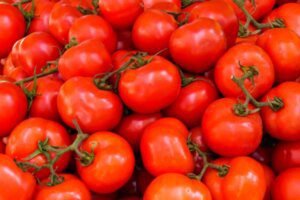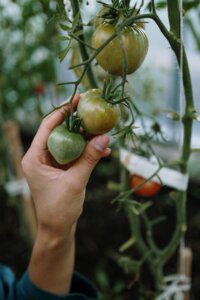One humble competitor in the world of fruits and vegetables stands out with its vivid colours and mouthwatering flavours—the tomato! The tomato, which is frequently misidentified as a vegetable, is actually an aggregate fruit that is loaded with nutrients and culinary possibilities.
This versatile ruby has been spicing up our lives for ages, adding flavour to everything from refreshing salads to hearty sauces. Explore the interesting history, outstanding health advantages, types and delectable culinary applications of the beloved tomato with us as we embark on a tasty adventure.

A historical journey
The tomato originated in the Mountains of South America and slowly spread across the planet, reaching Europe in the 16th century and capturing the taste buds of people all over the world. Cooks and diners have been attracted by its brilliant shades of red, orange, yellow, and even green for years.
It’s interesting to note that because they are members of the nightshade family, tomatoes were previously feared and viewed with distrust all over Europe. Today, though, their unique tastes and health advantages grace every cuisine, earning them a place on our plates and in our hearts.
Nutrition value and health benefits of a tomato
Tomatoes are an excellent complement to any diet because they are loaded with a variety of vital nutrients. The following are a few of tomatoes’ nutritional benefits:
Vitamins
Tomatoes are a rich source of vitamin C which strengthens the immune system, nurtures skin health, and acts as an antioxidant. They also include vitamin A, which is beneficial for immune system health and vision.
Related: 4 Incredible Natural Sources of Vitamin K to Incorporate into Your Diet
Minerals
Tomatoes are a good source of potassium, a necessary mineral that supports heart health and helps control blood pressure. Also, they have small levels of calcium, magnesium, and phosphorus, all of which support healthy bones.
Antioxidants
Lycopene, beta-carotene, and flavonoids are just a few of the antioxidants found in tomatoes. The particularly strong antioxidant lycopene, which gives tomatoes their red colour, has been related to several health advantages, including lowering the risk of some cancers and protecting against oxidative stress.
Related: Black Sesame Seeds: 16 Health Benefits And Nutritional Values
Dietary fibre
Tomatoes are a good source of dietary fibre, which promotes gut health, helps in digestion, and can increase satiety, helping with weight management.
Low in Calories
Tomatoes are a great choice for people trying to maintain or lose weight while enjoying a nutrient-rich food because they are low in calories.
Hydration
95% of tomatoes are made up of water, which helps the body stay hydrated, especially in summertime.
Heart Health
The potassium, anti-oxidants, and fibre found in tomatoes work together to lower blood pressure, lower cholesterol levels, and save the heart from cardiovascular disease.
Skin Health
The antioxidants and vitamin C in tomatoes help to produce collagen, which supports healthy and young skin. They are also helpful in UV damage protection for the skin.
Eye Health
Tomatoes are rich in vitamin A, which is good for eyesight and may help lower the risk of age-related macular degeneration.
Cancer Prevention
Lycopene, a powerful antioxidant found in tomatoes, has been associated with a lower risk of developing some cancers, including stomach, breast, lung, and prostate cancers. This preventive action of lycopene is believed to be influenced by its capacity to neutralize dangerous free radicals.
Digestive Health
The dietary fibre in tomatoes helps with digestion and fights against constipation. Also, it supports a balanced gut microbiota, which is necessary for good digestive health in general.
Weight Management
Tomatoes are a delicious food that can help reduce hunger and help in weight management because they are low in calories and high in fibre.
Bone Health
Tomatoes are a good source of calcium and vitamin K, both of which are necessary for maintaining healthy bones and lowering the risk of fractures.
Anti-Inflammatory characteristics
Lycopene and beta-carotene, two chemicals found in tomatoes, have anti-inflammatory characteristics that can help to lessen bodily inflammation and reduce the risk of chronic diseases.
Blood Sugar Control
According to some studies, tomatoes may help boost insulin sensitivity and control blood sugar levels, which makes them advantageous for people with diabetes or those who are at risk of getting the disease.
Also read this: Sugar Cravings At Night: 18 Best Tips for Regaining Control
Support for the Immune System
Tomatoes are a good source of vitamin C, an important antioxidant that strengthens the immune system and helps in the body’s defence against diseases and infections. Regular tomato consumption can help boost your immune system’s defences.
Nutritional value
Tomatoes are a fruit that is rich in nutrients and gives several important vitamins, minerals, and antioxidants. The approximate nutritional value of a medium-sized (about 123 grams) uncooked tomato is as follows:
- Calories: 22
- Metabolites: 4.8 grams
- Nutritional Fiber: 1.5 grams
- 2.6 grams of sugars
- 1.0 grams of protein
- 0.2 grams of fat
- 15.6 milligrams of vitamin C (26 per cent of the daily value)
- 1025 IU of vitamin A (21% of the daily value)
- 7.9 micrograms of vitamin K (10% of the daily value)
- 292 milligrams of potassium (8 per cent of the daily value)
- 15.6 micrograms of folate (4% of the daily value).
- 0.1 milligrams of vitamin B6 (4% of the daily value)
- 0.6 milligrams of niacin, or vitamin B3 (3% of the daily value)
- 11 milligrams of magnesium (3% of the daily value)
Including tomatoes in your diet regularly can provide a variety of nutritional advantages that improve overall health. Tomatoes are a versatile and delicious supplement to a balanced and healthy lifestyle, whether they are consumed raw in salads, cooked in sauces, or simply enjoyed as a fresh snack.
Related: Black Lentils: 9 Amazing Benefits and Nutrients
Which acid is present in tomato
The main organic acid responsible for tomatoes’ unique acidity is citric acid. The weak acid that gives tomatoes their sour and tangy flavour is also found in other fruits like oranges and lemons. Citric acid levels are higher in ripening tomatoes, which enhances the overall flavour profile. Tomatoes’ natural acidity gives them their sour flavour, but it also preserves them and improves the flavours of salsas, soups, and sauces made with them. It is necessary to achieve flavour harmony in a variety of dishes and to preserve tomato products in cans.
Types of tomatoes
There are many different tomato varieties, and each one has special qualities, tastes, and applications. Here are a few popular tomato varieties:
Beefsteak Tomatoes
Large, meaty tomatoes with a lovely texture are known as “beefsteak” tomatoes. They are fantastic for slicing and adding to salads, burgers, and sandwiches.
Roma (Plum) Tomatoes
Roma (Plum) tomatoes have fewer seeds and an oval form with a firmer, meatier texture. They are frequently employed in the production of pastes, sauces, and canned tomatoes.
Cherry Tomatoes
Cherry tomatoes are delicious, tiny, and rounded in shape. They are ideal as a side dish when roasted or as a snack or addition to salads.
Grape Tomatoes
Grape tomatoes are little and long, much like cherry tomatoes. They have a sweeter flavour and are ideal for salad toppings and snacks.
Heirloom Tomatoes
Heirloom tomatoes come in a variety of shapes, colours, and forms. They are non-hybrid varieties, and people enjoy them for their distinctive flavours and looks.
Campari Tomatoes
A variety of cocktail tomatoes is smaller than an ordinary tomato but a little bigger than a cherry tomato. They are delicious in salads and as an appetizer.
Green Tomatoes
Unripe tomatoes with an acidic, slightly sour flavour are known as “green tomatoes.” They are frequently fried or added to pickles and chutneys.
Oxheart tomatoes
These big, heart-shaped tomatoes are valued for their delicious, meaty flesh. They are perfect for slicing and incorporating into salads and sandwiches.
San Marzano Tomatoes
San Marzano tomatoes are a variety of plum tomatoes that are elongated, have fewer seeds, and have higher water content. They are regarded as quality cooking tomatoes and are often used for creating sauces.
Yellow tomatoes
When compared to the red variety, yellow tomatoes have a milder and sweeter flavour. They provide salads and other foods a vivid colour.
These are but a few of the many available tomato varieties. Tomatoes are a flexible and important ingredient in a wide variety of dishes since each type has a unique taste and uses in cooking.
Culinary uses
Tomatoes are very versatile and are usually used in different types of cuisine all around the world. Here are a few common culinary uses for tomatoes:
Fresh Tomato Salsa: A tasty and energizing salsa made from diced tomatoes, onions, cilantro, lime juice, and spices is ideal for dipping tortilla chips in or serving Mexican food.
Pasta sauces: Tomatoes are an important component of many pasta sauces, from the traditional marinara to the rich and creamy Alfredo with a tomato basis.
Pizza Toppings: Sliced or diced tomatoes give pizzas a taste boost that goes well with the cheese and other toppings.
Tomato Soup: Warm and cosy tomato soup is a traditional favourite that is frequently eaten with a side of grilled cheese.
Salads: Whether it’s a straightforward Caprese salad with mozzarella and basil or a filling Greek salad with cucumbers and olives, tomatoes are a main ingredient in salads.
Salsa and dips: Tomatoes can be blended or pureed to create savoury spreads and dips, like tomato hummus or roasted tomato spread.
Chili & stews: Tomatoes are a prominent ingredient in hearty stews and chilli, which give the food flavour and richness.
Tomato juice: A popular drink that is usually enjoyed as a healthy and energizing beverage is freshly squeezed tomato juice.
Stuffed Tomatoes: Hollowed-out tomatoes can be filled with several ingredients, such as rice, quinoa, or cheese, and then baked until soft.
Tomato-based Curries: Tomatoes are frequently used as the foundation for curries in Indian and Thai cuisines, adding a tangy and savoury flavour.
Tomato Bruschetta: A delicious appetizer made of toasted bread that has been topped with diced tomatoes, garlic, olive oil, and basil.
Tomato Gazpacho: Spanish soup prepared with blended tomatoes, cucumbers, peppers, and other vegetables is called tomato gazpacho.
Tomato Chutney: Tomato chutney is a tangy, hot condiment used in Indian food that is created from stewed tomatoes, onions, and different spices.
Tomato Jam: With sugar and spices added, tomatoes are slowly cooked to create tomato jam, a sweet and savoury spread that goes well with cheese and crackers.
Tomato Sauce for Meat and Fish: To add flavour and moisture to meat and fish meals, tomatoes can be used to make delicious sauces.
These are only a few examples of the various ways tomatoes can be used in a variety of cuisines, showing their amazing versatility and flavour-improving abilities. Tomatoes are an important ingredient in many well-loved recipes from throughout the world, including appetizers, main courses, and even drinks.
How to grow tomatoes

No matter if you have a huge garden or just a small balcony, growing tomatoes can be a profitable and joyful experience. To grow tomatoes successfully, follow these steps:
1. Select the Best Tomato Variety
There are a wide variety of tomatoes available, each with unique qualities. When choosing the ideal variety for your needs and area, take into account elements like the size of the fruit, the maturation period, and whether it is determinate (bushy) or indeterminate (vining).
2. Pick a Sunny Spot
Tomatoes do best in direct sunshine. A location with at least 6 to 8 hours of direct sunlight each day should be chosen in your garden or on your balcony.
3. Prepare the Soil
Tomatoes recognize organically rich, well-draining soil. Before planting, enrich the soil with compost or old manure to add vital nutrients and enhance soil quality.
4. grow from Seeds or Seedlings
You may either buy small seedlings from a nursery or grow tomato plants from seeds indoors six to eight weeks before the final expected date of frost. Once the earth has warmed up and all threat of frost has passed, transplant seedlings outside.
5. Planting and Space
Bury the seedling a little bit deeper than it was in the container by digging a hole big enough to hold the root ball. Plants should be placed in rows 18 to 24 inches apart or in containers with enough room for root development.
6. Watering
To grow well, tomatoes require regular watering. To ensure the roots have enough moisture, deeply water the plant at the base. Avoid overhead irrigation because moist leaves might harbour disease.
7. Mulching
Cover the base of the plants with a layer of organic mulch, such as straw or wood chips. Mulch reduces weed growth, controls soil temperature, and aids in soil moisture storage.
8. Support and Pruning
To keep the plants erect and off the ground, indeterminate tomato varieties need support, such as stakes or trellises. To concentrate energy on the main stem for fruit production, remove suckers (side shoots).
9. Fertilizing
To provide the plants with vital nutrients during the growth season, feed them with a balanced fertilizer or compost tea every few weeks.
10. Pest and Disease Control
Routinely look for pests and disease symptoms on the plants. When organic pest management is required, remove any infected leaves or fruits right away.
11. Harvesting
Ripe tomatoes should be picked when they are completely pigmented and firm. If it gets cold outside, let green tomatoes ripen indoors.
Throughout the growing season, you may enjoy a plentiful crop of delectable, homegrown tomatoes by following these instructions and giving your plants the proper care. Enjoy your garden!
FAQs
1. Are tomatoes only available in red?
Tomatoes do not just come in red; they also come in orange, yellow, green, and even purple. You can experiment and taste a rainbow of tomato delights because each hue delivers its own distinctive flavour profile and culinary possibilities.
2. Can I grow tomatoes in a small space or container garden?
Absolutely! On balconies, patios, or small gardens, tomatoes can be grown successfully in pots. Choose compact or dwarf kinds designed especially for container gardening, and make sure they get enough light and maintenance regularly for a satisfying yield.
3. What are some creative ways to use tomatoes in recipes?
There are countless uses for tomatoes because they are so adaptable. Take pleasure in them in soups, salads, sandwiches, pasta dishes, sauces, and salsas. Use them as a base for savoury jams and spreads or roast them to enhance their flavor. For a longer shelf life and distinctive flavour experiences, you can even pickle or dehydrate tomatoes.
4. How can I preserve an abundant tomato harvest?
If you have an excess of tomatoes, think about canning, freezing, or drying them. While freezing keeps the flavour and nutrition of fresh tomatoes, you can preserve tomato sauce or chopped tomatoes for later use. You may rehydrate dried tomatoes to use in a variety of cuisines or add them to salads.
5. Are there any health benefits associated with tomatoes?
Vitamins A, C, and K, as well as anti-oxidants like lycopene, are among the vital components that are rich in tomatoes. Particularly, lycopene has been related to several health advantages, such as promoting heart health and lowering the chance of developing several chronic diseases.
6. Can I grow tomatoes all year round?
Vitamins A, C, and K, as well as anti-oxidants like lycopene, are among the vital components that are rich in tomatoes. Particularly, lycopene has been related to several health advantages, such as promoting heart health and lowering the chance of developing several chronic diseases.
7. How do I deal with common tomato plant pests and diseases?
Use natural pest control techniques like neem oil or insecticidal soap and regular monitoring to manage common pests like aphids, caterpillars, or whiteflies. Use disease-resistant tomato cultivars, practice excellent garden cleanliness, and steer clear of overwatering to combat illnesses like blight or wilt.
8. Can I save tomato seeds for future planting?
You can indeed save tomato seeds for later planting. Scoop off the seeds from the tomatoes after they have fully ripened on the vine, and let them dry on a paper towel. For planting the next year, keep them in a labelled envelope in a cool, dry location.
9. Are there any tomato varieties suitable for beginners to grow?
Absolutely! Some tomato cultivars, including “Roma,” “Early Girl,” and “Cherry,” are well renowned for being beginner-friendly and simple to grow. These types are a great option for beginning gardeners because they are hardy, disease-resistant, and require little upkeep.
10. How do I know when tomatoes are ripe and ready for harvest?
Depending on the type, tomatoes should be firm and bright in colour. Additionally, they are supposed to smell good and come away from the vine with a light tug. Your tomatoes will have the most flavour and nutritional value if you harvest them when they are at their ripest.
To sum up, producing tomatoes is a pleasant and enjoyable experience that allows you to enjoy a variety of homegrown food. With the proper care, you may enjoy these vivid fruits’ flavorful versatility in salads, sauces, and a wide range of other culinary creations. The process of growing tomatoes from seeds to harvest, whether you have a large garden or a little plot, is rewarding and connects you to the wonder of nature and the satisfaction of creating your own food. So get your hands dirty, enjoy gardening, and start growing tomatoes; it will be a fun trip with tasty rewards. Enjoy your garden!


